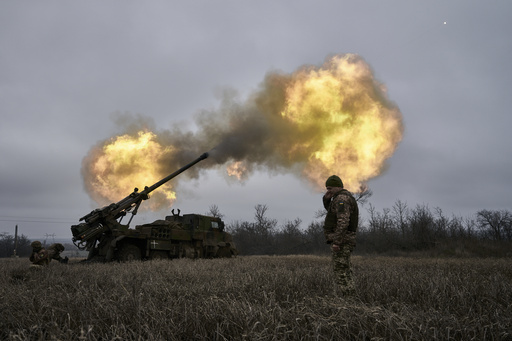LONDON — While dialogue continues between the U.S. and Russia regarding the ongoing conflict, discussions have intensified in Europe regarding a plan aimed at preventing further Russian aggression. As political and military leaders work out the details, Ukraine remains absent from these important deliberations.
In recent months, the proposal has gained visibility, and it is anticipated to be raised when U.K. Prime Minister Keir Starmer and French President Emmanuel Macron visit Washington next week to meet with U.S. President Donald Trump. Starmer, set to arrive on Thursday, has emphasized the importance of American military support for the initiative, which may prove challenging to secure from Trump.
What does this plan entail? Ideally, Ukrainian President Volodymyr Zelenskyy seeks NATO membership as a security guarantee, a goal still supported by European NATO members; however, the U.S. appears to be moving away from this notion. Zelenskyy has indicated that in the absence of NATO accession, over 100,000 European troops might be required to prevent a resurgence of conflict following a ceasefire.
Nonetheless, officials in the West clarify that the current discussions revolve around a “reassurance force,” rather than a full-scale peacekeeping army deployed along the extensive 600-mile front line in eastern Ukraine. The initiative, backed by the U.K. and France, envisions fewer than 30,000 troops stationed away from frontline conflicts, focusing instead on critical infrastructure sites like nuclear power facilities and relying on Western air and naval capabilities.
The surveillance of the front line would largely be conducted through advanced technologies, including drones. Air support would be stationed outside Ukraine—possibly in Poland or Romania—ready to mitigate any violations and facilitate the resumption of commercial flights in Ukrainian airspace. Notably, U.S. air assets could also form part of this strategy.
“There must be a U.S. backstop,” Starmer asserted, “because a U.S. security guarantee is the only means to effectively deter further Russian aggression against Ukraine.”
What’s the American perspective? Trump has historically reiterated that NATO allies should invest more in their own defense and that Europe must take greater responsibility for its safety. U.S. Defense Secretary Pete Hegseth conveyed to European allies that there will be no American troops sent to Ukraine but did not dismiss the possibility of support in logistical or air transportation capacities.
During a NATO visit this week, Gen. Keith Kellogg, Trump’s designated envoy on Ukraine, pointed out the need to keep all options open as the dynamics of any prospective force will largely hinge on the results of future peace negotiations. Jamie Shea, a former senior NATO representative, noted the conflicting signals from various administration officials, raising questions about whom to trust in these discussions.
It remains uncertain how Ukraine will react to the proposed plan. Russia’s Foreign Minister Sergey Lavrov has already rejected the concept outright, labeling the potential deployment of NATO troops—regardless of any formal alliance affiliation—as “unacceptable” to Moscow.
Are other European nations supportive? The U.K., France, and Nordic and Baltic countries, which are closest to the Russian borders, appear poised to play leading roles in this initiative. Countries like Italy are constrained by constitutional limitations regarding military deployments, while in nations such as the Netherlands, parliamentary consent would be necessary to send troops. Polish Prime Minister Donald Tusk indicated that Poland would refrain from sending troops into Ukraine, given its strategic role as a logistics hub since Russia’s comprehensive invasion nearly three years ago.
Following a rapid convening of European leaders in Paris to deliberate on the conflict, German Chancellor Olaf Scholz characterized discussions surrounding a European-led security force as “premature.” He expressed concern over the timing of deliberations on peacekeeping forces, insisting that NATO should remain the cornerstone of collective security measures.
Could this plan be successful? The effectiveness of the initiative relies on the nature of any eventual peace agreement. With approximately 600,000 Russian troops currently in Ukraine, experts argue that a ceasefire permitting a substantial Russian military presence could lead to renewed hostilities. France maintains around 200,000 military personnel, while the U.K. has limited resources at fewer than 150,000 troops.
According to Matthew Savill from the Royal United Services Institute, Europe would face challenges in assembling a deployable force in the tens of thousands. “European countries will have a limited ability to sustain troop deployments over multiple rotations, which may extend for years,” he remarked.
It could take a considerable amount of time to assess the results of any peacekeeping operation. Michael Clarke, who teaches war studies at King’s College London, pointed out that historical examples of peacekeeping in areas like Cyprus and Lebanon have lasted several decades. “If this initiative succeeds, it could be in place for 20 or 30 years. Conversely, failure could lead to renewed fighting within two years,” he cautioned.
Lithuania’s defense minister, Dovil? Šakalien?, acknowledged the validity in the Trump administration’s critical view of Europe’s military capabilities. “Russia is gearing up for a prolonged conflict,” she warned. “They now possess three times the manpower, and their defense capabilities are evolving more rapidly compared to Europe. We need to acknowledge that this situation extends beyond Ukraine.”
“The credibility of security guarantees from a weakened entity is questionable,” she added. “Europe urgently needs to reinforce its capabilities to deliver reliable security assurances.”




